Core Strength
Yeah, I realize that this page is listed under stretches; and “Core Strengthening” is not really stretching — and certainly not something I prescribe patients who have just undergone TISSUE REMODELING. However, if you want to have a strong spine and good posture (both critical for good overall health), you’ll need to work on your core. Since most people simply think of the ‘core’ as being your Abdominal Muscles, I am going to use this platform to dispel that myth.
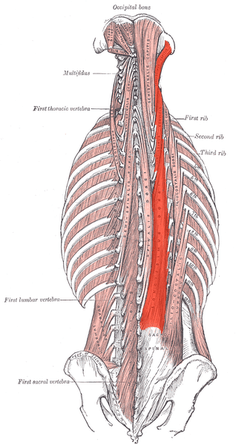 |
 |
Do abs like those in the picture to the left indicate a strong core? Maybe. But not necessarily. Even though it seems like everyone wants to sell you their program, pill, potion, or equipment for building ‘chiseled’ abs, most of them don’t deliver. And those that do, run the risk of creating a problematic situation (namely LOWER CROSSED SYNDROME or UPPER CROSSED SYNDROME). You see; that incredible six pack may be the very thing confusing us about what Core Training is really all about.
For one thing, no matter how hard you work your abs, you will never look like this guy unless you get your body fat down to the 4 – 5% range — difficult unless you are a genetic freak or committed to LOW CARB, PALEO, or a KETOGENIC DIET. And even if you have the best abs on the planet, but they are covered by a thick layer of butter, no one will know. And unfortunately, simply doing more ab workouts or tougher Core Conditioning does not independently reduce belly fat. There is only one effective way to stay lean and healthy at the same time (HERE). Furthermore, just because you happen to have abs like Fabio does not mean that your core is strong or stable. Personal experience tells me that if you have a low enough body fat, moderate numbers of situps can give you abs like his. The problem is that situps (or most types of crunches) can also leave you with all sorts of injuries, including HERNIATED DISCS!
Despite what the guy that owns your gym may have told you, ‘Core Strength’ is not just a fancy way of talking about getting the proverbial “Six Pack” by doing a million situps a day. If you have followed my blog, you are probably aware of the work of the legendary biomechanist Dr. Stuart McGill. McGill has been doing research on the best methods for strengthening and training the core for over three decades, and is considered the world’s foremost expert on the topic. He has definitively shown that situps are not only not good for you, they are actually dangerous — dramatically increasing your chances of Herniating a Disc. Let me show you why Core Strength goes far beyond simply having a flat mid section. This is probably a good time to tell on myself. I quit doing situps and crunches years ago. Here’s why. I had developed a HIP FLEXOR TENDINOSIS that I could not figure out. I would fix it and it would come right back. A friend of mine (a biomechanist) told me to get over my hang up about planks (I thought they looked ‘sissy’ and refused to do them). Needless to say, I stopped doing sit ups and have not had the hip problem since. Hey; sometimes we call all benefit from a good slap in the face!
I cannot tell you how many patients I have whose back problems are the result of a weak core. This is usually due to a sedentary lifestyle and complete (or nearly so) lack of exercise. But on occasion I see people who focus on one specific exercise. This can lead to serious muscle imbalance. When this happens in the core it can be devastating. It’s true. Even athletes or those with ‘great abs’ (the proverbial sixpack) can fool themselves. Hey, it happened to me. As I told you, I fooled myself for years with situps — as well as with food (HERE). If you have great looking abs but are failing to train muscles other than the Rectus Abdominus (the sixpack muscle), you are fooling yourself about your Core Strength. In fact, there are many experts who would tell you that the Rectus Abdominus is not even a true ‘Core’ muscle. And let me add one more tidbit while we are at it. Those of you who think you don’t need to train your core because you are not an athlete —- you are fooling yourself as well. Every time you pick up your grand baby, grab a sack of groceries from the back seat, vacuum your carpet, split firewood, rake leaves, work around the yard, or swing a golf club, tennis racquet, or softball bat, you use your core. A weak core dramatically increases your chances of future hip, back, knee, neck, and shoulder problems!
Dictionary dot com defines Core Strength thusly, “The strength of the underlying muscles of the torso, which help determine posture“. While this is not a terrible definition, it is way oversimplified. Although there is a general consensus that core strength and stability are important, there is less agreement on the exact definition of “Core Strength” and “Core Stability”. Back in the early 90’s, expert in biomechanics, Dr. Manohar Panjabi (coauthor of Clinical Biomechanics of the Spine — a book I own), said that spinal stability consists of three specific parts.
- Passive Tissues of the Spinal Column
- Active Control via Spinal Muscles
- Neuromuscular Control / Coordination
Your core is made up of several different muscles. It is also made up of several layers of muscles (HERE are two very cool ten-second videos on this fact). Like I have shown you, too many people are just worried about the muscles they can see (the abs and the obliques). The truth is that it the muscles that you cannot see that are undoubtedly the most important. These include muscles like the Psoas and the Spinal Erectors (see middle picture at the top). But the core does not stop there. Most experts will tell you that any muscle that attaches to the pelvic girdle is considered part of the core. This includes the glutes, hip flexors, lats, etc, etc (you can find lists online, although no two will be identical). These muscles all act synchronously to stabilize the spine and skeleton while standing, squatting, sitting, lifting weights, running, playing sports, etc, etc. When the muscles in the hip / pelvic girdle, trunk / torso, shoulder girdle, spinal erectors / spinal extensors (both superficial and deep), and abdominal muscles work together like they should, it creates a functional unit called “The Core”.
Although I do not deal with enough elite athletes to belabor the difference, technically speaking Core Strength is the term used to describe the strength these muscles as measured by how much they are able to lift and how many times (or how long a time) they can lift it while maintaining proper form. A simple measure of Core Strength would be to see how long a person can hold a plank (BTW, I have a 50+ year old female patient who can hold a plank for the better part of 10 minutes!). Core Stability is more of a function of coordination. It is a measure of how well the alignment of the spine and pelvis are while going though specific activities or motions — particularly while the arms and legs are moving. Here’s the cool thing. With the advent of programs such as Cross-Fit, those who are so inclined can go online and find multitudes of really amazing Core Exercises that can be done in your home with very little actual equipment. In a moment I am going to show you some starters.
If you are an athlete, Core Strength (also known as ‘Functional Strength‘) should be developed in a manner consistent with the particular sport(s) you play. Allow me to give you an example. Have you ever noticed how much of what people think of as “Core Training” involves laying on you back, on the ground, and staring up at the ceiling (i.e. sit ups). Think about this position for a moment. This is the position of a wrestler as he is being pinned! Training your core should be multi-positional and dynamic. In other words it should involve many complex movements and have an emphasis on TRUNK EXTENSION. The ideal ‘Core Training Program’ should have movements where the body is held still relative to the extremities which are moving (Bird Dogs or Lunges are two examples). These exercises should attempt to increase strength and endurance and involve motions that cross the mid line (spinal rotation). It should also involve increasing balance and stability via unstable surfaces such as Exercise Balls, Bossu Balls, WHOLE BODY VIBRATION MACHINES, Wobble Boards, etc.
THE EFFECTIVENESS OF THE EXERCISE BALL IN CORE TRAINING & CORE STRENGTH
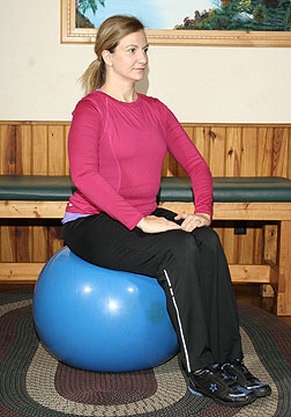
BALL CRUNCHES AND SIDE CRUNCHES
When done properly, crunching on the ball is a good thing. It’s different than the standard crunch or situp — note how little difference there is between position I and position II — the spine never goes into flexion. Even Dr. Stuart McGill teaches a modified crunch (a crunch that can be difficult to learn because it locks out lumbar motion and has to be done in a very specific manner). Make sure that you do some side crunches for your oblique muscles as well. To make this exercise more difficult, you can put the feet together or even stabilize with one foot off the ground.
Notice how her lumbar spine remains in extension throughout the crunch. This is the one and only way to properly do a crunch:
| BALL CRUNCH POSITION I |
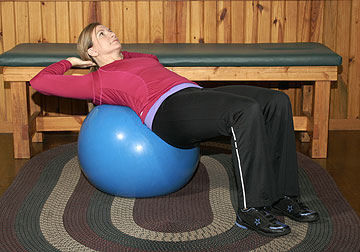 |
| BALL CRUNCH POSITION II |
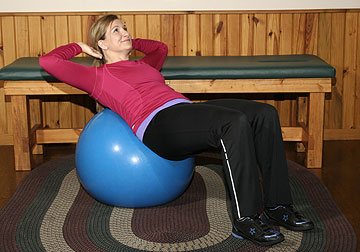 |
| EXERCISE BALL SIDE CRUNCH |
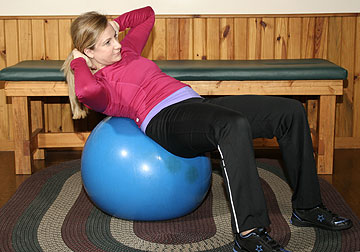 |
INCREASINGLY DIFFICULT BALL EXERCISES
| SUPERMAN HYPEREXTENSION ON AN EXERCISE BALL |
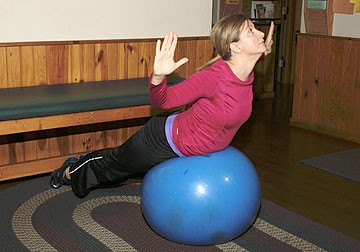 |
| REVERSE HYPEREXTENSION FROM AN EXERCISE BALL |
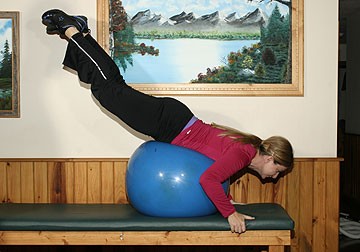 |
| STIR THE POT |
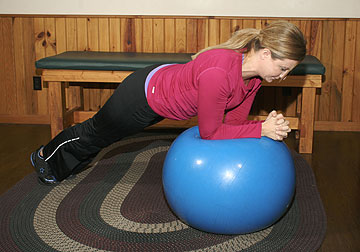 |
Exercising on unstable surfaces builds stability into your core / spine. So, how better to build core stability than working out on an Exercise Ball? It is both cheap (a good, burst-resistant ball can be purchased online for 20 bucks or so) and effective. Like I said earlier, traditional sit ups and crunches are a thing of the past. If anyone is still telling you that situps or crunches are a good thing in light of the astounding number of studies to the contrary, they simply don’t know better. The only way that I recommend a person does any crunches at all is to do partial crunches (very partial) done from an exercise ball — with no spinal flexion whatsoever. These pictures are just the tip of the iceberg as far as how you can incorporate a ball into your training regimen. The truth is, I recommend that people do as many exercises as possible with an exercise ball. Let me give you an example of why by using an exercise we are all familiar with as an example — the bench press.
Let’s say you are going to do some bench presses. In a traditional bench press, you would lay on a totally stable bench and stabilize yourself further by taking as wide a stance as possible with your feet. Needless to say, you are very stable. But this is not the best way to do the exercise. Instead, do your bench presses from a heavy duty (burst resistant to 1,000 lbs) Exercise Ball. Use lighter weight, individual dumbells instead of a single barbell, and feet as close together as you can do without falling over. The key is to try introducing instability into multiple points of each exercise you do, whether bench pressing, doing biceps curls, or lunges, or whatever. Instability in the exercise builds stability into your spine and core! You can also use a Bosu Ball for many exercises. The Bosu Ball is like an Exercise Ball that has been cut in half with a solid top that you can sit or stand on. Not that I recommend it for anyone, but I have actually seen people doing Two-Handed Kettlebell Swings with each foot planted on a Bosu. Speaking of Kettle Bell Swings….
KETTLEBELL SWINGS. BUILD YOUR OWN KETTLEBELL (HOW TO MAKE YOUR OWN HOMEMADE KETTLEBELL)
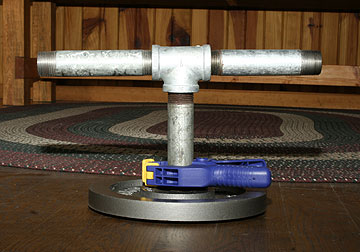 | 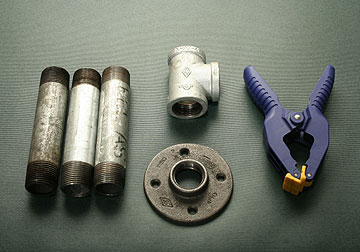 |
Kettle Bells are expensive. Especially if you start buying lots of different sizes / weights. Here is a simple solution. Go down to your local hardware store and get the things in the picture. You’ll need a three way adapter, three six inch pipe nipples (yeah, that’s what they’re called), and a mount. The clamp is simply to keep the weight from sliding up and down the shaft. Since I use Olympic Weights, I use 1″ pipe. If your weights are smaller, use smaller pipe. I don’t tape the threaded ends (although I recommend that you do). I always wear heavy duty leather work gloves when doing Kettle Bell Swings.
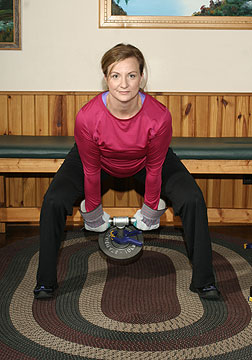 |
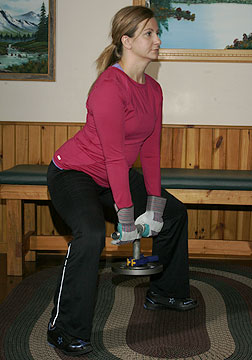 |
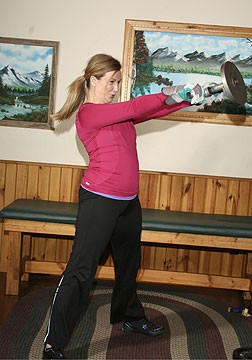 |
 |
I used to think that squats were the absolute best whole-body exercise a person could do. After learning about Two-Handed Kettle Bell Swings a few years ago, I began to rethink that assertion. I am not sure there is a muscle in your body that the Kettle Bell Swing does not work — including the core. But the main muscle groups being worked are the butt (glutes) and hamstrings. Forget about the ‘Buns of Steel‘ workout videos. One set of Kettle Bell Swings two times a week will do amazing things for your body in a short amount of time. Let’s talk for a moment about doing Kettlebell Swings the correct way. Before we continue, I want to mention that although the Cross Fit crowd likes to finish their Kettlebell Swings with the Kettlebell at 12:00 high —– totally over their head (The American Swing); I prefer the Russian Swing as shown in the picture series above. I don’t like or recommend the American Swing. But if that tickles your fancy, go for it.
- Stand in a squatting position with a fairly wide stance —- feet about six inches or so outside of your shoulders.
- Point your toes outward about 20 degrees or so. You’ll note that in the first picture of the series above, Sara is not doing this. You can see how she drives onto the outside portion of her feet. Solve this by toeing out.
- Keep your shoulders back and your low back arched (stick your butt out slightly). This will help keep you in a safe position and keep you from rounding your back.
- You want to always keep you shoulders back behind your knees.
- You want to keep your abs tight through the entire exercise (by the way, this exercise is the quickest way I know do develop a strong core and great abs).
- As you come up, contract your butt muscles (hard) and arch backwards slightly.
- Think of the Kettlebell as the weight at the end of the pendulum. The force driving the Kettlebell upward does not come from your arms, chest, or shoulders. It comes from the hips and pelvis.
- Do one single set of 50-75 reps, twice a week. If you cannot do that many when you start, don’t sweat it. Do what you can and go from there.
- If you experience pain, stop. I realize that this is a no-brainer, but do not try and push through serious pain with this or other exercises.
PLANKS AND SIDE PLANKS
There is a growing group of Research Biomechanists (people who study the way the spine works for a living) who are all saying the same thing. DO NOT DO SITUPS! They are largely correct. Sit ups cause problems. Years ago, I caused myself all sorts of problems by doing unholy numbers of situps — all the while thinking I was doing myself a favor. What can I say? Live and learn. What should take their place? Although I think the Kettlebell Swings are the best thing going; they are definitely not a beginner’s exercise. You need to start with Planks and the various versions thereof. Planks are done by getting into pushup position (first or third picture above) and holding it. Once you have mastered the Plank, you can move on to Side Planks. I like to roll from Plank to Side Plank to Plank to other Side Plan, holding each one as long as I can.
Once you are really good at Planking, you can graduate to the Stir-the-Pot exercise. This is a barn-burner of a Core Exercise! The Stir the Pot is simply a moving Plank done on an Exercise Ball. Get in the Forearm Plank position with you forearms on an Exercise Ball instead of on the ground. Now start moving your arms / elbows in circles —- just like stirring a pot. Confused? Just watch the videos below. You may want to start out by doing this exercise from your knees (first video below). You can then graduate to the second video —- take 10 seconds to watch it. You can tell how tough this exercise is by watching how Sara strains to stay on the ball. But the payoff is incredible. You will strengthen your back and midsection like you never have before!
| PUSHUP POSITION PLANK |
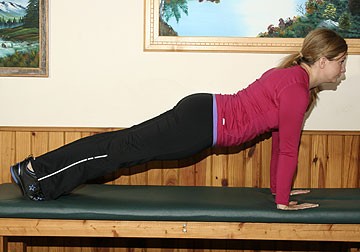 |
| PUSHUP POSITION SIDE PLANK |
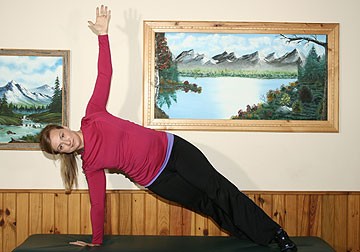 |
| FOREARM PLANK |
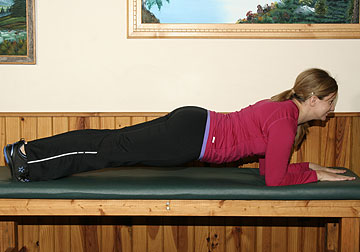 |
| FOREARM SIDE PLANK |
 |
